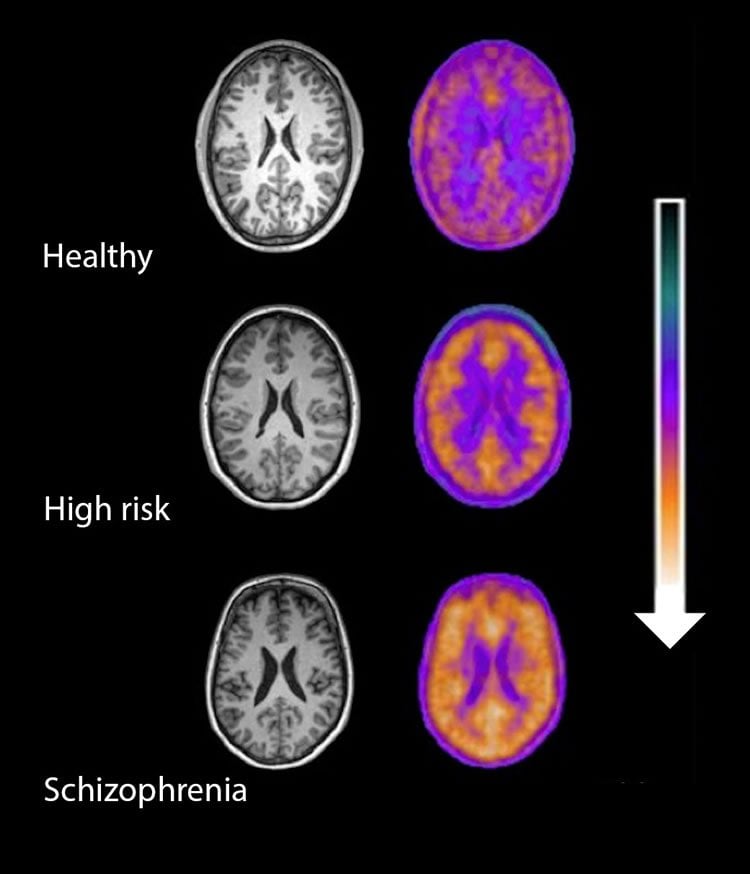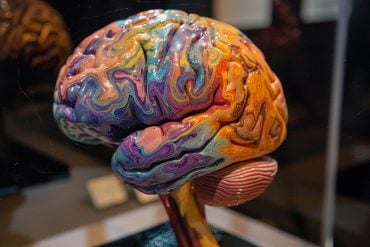A study, published today in the American Journal of Psychiatry, is the first to find that immune cells are more active in the brains of people at risk of schizophrenia as well as those already diagnosed with the disease.
The finding could completely change our current understanding of schizophrenia, raising the possibility that testing people most at risk of the disorder ahead of time could allow them to be treated early enough to avoid its most severe symptoms.
Researchers at the Medical Research Council’s (MRC) Clinical Sciences Centre, based at Imperial College London, in collaboration with colleagues at King’s College London used positron emission tomography (PET) scans to measure levels of activity of immune cells in the brain. These cells, known as microglia, respond to damage and infection in the brain, and are also responsible for rearranging the connections between brain cells so that they work as well as possible; a process known as pruning.
The team tested a group of 56 people including those already diagnosed with schizophrenia, those at risk of the disease and those with no symptoms or risk of the disorder. They found that activity levels of microglia in the brain increased according to the severity of symptoms in people with schizophrenia and that people with diagnosed schizophrenia had high levels of activity of these immune cells in their brain.
Peter Bloomfield, lead author of the study at the MRC Clinical Sciences Centre, said: “Our findings are particularly exciting because it was previously unknown whether these cells become active before or after onset of the disease.
“Now we have shown this early involvement, mechanisms of the disease and new medications can hopefully be uncovered.”
Dr Oliver Howes, head of the psychiatric imaging group at the MRC Clinical Sciences Centre, added: “Schizophrenia is a potentially devastating disorder and we desperately need new treatments to help sufferers, and ultimately to prevent it.
“This is a promising study as it suggests that inflammation may lead to schizophrenia and other psychotic disorders. We now aim to test whether anti-inflammatory treatments can target these. This could lead to new treatments or even prevention of the disorders altogether.”

Professor Hugh Perry, Chair of the Neuroscience and Mental Health Board at the MRC, added “Schizophrenia, like other mental health disorders, is a complex disease that we know is caused by an interplay of genetic, behavioural and other contributing factors.
“This study adds to a growing body of research that inflammation in the brain could be one of the factors contributing to a range of disorders – including Alzheimer’s, schizophrenia and depression – and with this new knowledge comes the hope of life-changing treatments.”
Funding:Source: Susan Watts – MRC
Image Source: The image is adapted from the MRC press release
Original Research: Abstract for “Microglial Activity in People at Ultra High Risk of Psychosis and in Schizophrenia: An [11C]PBR28 PET Brain Imaging Study” by Peter S. Bloomfield, Sudhakar Selvaraj, Mattia Veronese, Gaia Rizzo, Alessandra Bertoldo, David R. Owen, Michael A.P. Bloomfield, Ilaria Bonoldi, Nicola Kalk, Federico Turkheimer, Philip McGuire, Vincenzo de Paola, Oliver D. Howes in American Journal of Psychiatry. Published online October 16 2015 doi:10.1176/appi.ajp.2015.14101358
Abstract
Microglial Activity in People at Ultra High Risk of Psychosis and in Schizophrenia: An [11C]PBR28 PET Brain Imaging Study
Objective:
The purpose of this study was to determine whether microglial activity, measured using translocator-protein positron emission tomography (PET) imaging, is increased in unmedicated persons presenting with subclinical symptoms indicating that they are at ultra high risk of psychosis and to determine whether microglial activity is elevated in schizophrenia after controlling for a translocator-specific genetic polymorphism.
Method:
The authors used the second-generation radioligand [11C]PBR28 and PET to image microglial activity in the brains of participants at ultra high risk for psychosis. Participants were recruited from early intervention centers. The authors also imaged a cohort of patients with schizophrenia and matched healthy subjects for comparison. In total, 56 individuals completed the study. At screening, participants were genotyped to account for the rs6971 polymorphism in the gene encoding the 18Kd translocator protein. The main outcome measure was total gray matter [11C]PBR28 binding ratio, representing microglial activity.
Results:
[11C]PBR28 binding ratio in gray matter was elevated in ultra-high-risk participants compared with matched comparison subjects (Cohen’s d >1.2) and was positively correlated with symptom severity (r=0.730). Patients with schizophrenia also demonstrated elevated microglial activity relative to matched comparison subjects (Cohen’s d >1.7).
Conclusions:
Microglial activity is elevated in patients with schizophrenia and in persons with subclinical symptoms who are at ultra high risk of psychosis and is related to at-risk symptom severity. These findings suggest that neuroinflammation is linked to the risk of psychosis and related disorders, as well as the expression of subclinical symptoms.
“Microglial Activity in People at Ultra High Risk of Psychosis and in Schizophrenia: An [11C]PBR28 PET Brain Imaging Study” by Peter S. Bloomfield, Sudhakar Selvaraj, Mattia Veronese, Gaia Rizzo, Alessandra Bertoldo, David R. Owen, Michael A.P. Bloomfield, Ilaria Bonoldi, Nicola Kalk, Federico Turkheimer, Philip McGuire, Vincenzo de Paola, Oliver D. Howes in American Journal of Psychiatry. Published online October 16 2015 doi:10.1176/appi.ajp.2015.14101358






